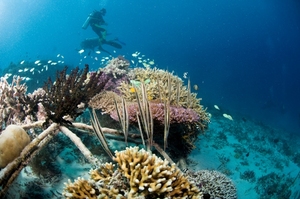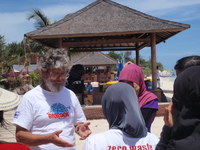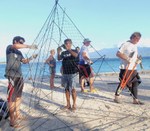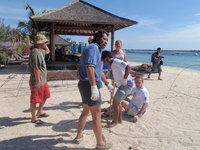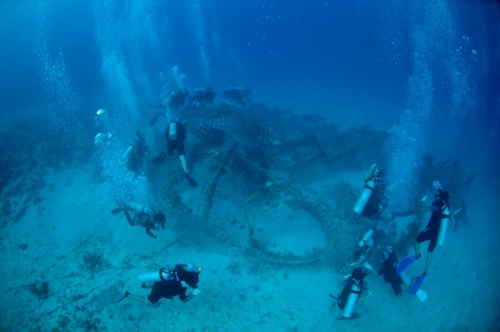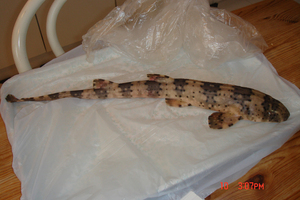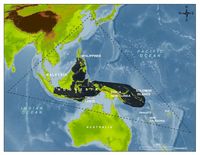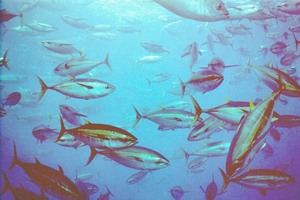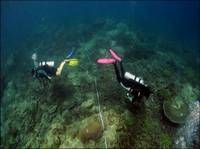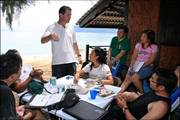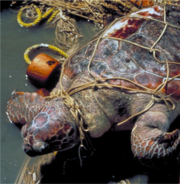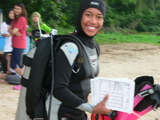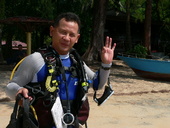Pangasinan, May 2009. With more and more people now inhabiting the world, the law of supply and demand needs not to be explained anymore. This is particularly true in the case of sea cucumbers, which are found in shallow waters inhabiting wide seagrass beds, soft bottom areas, and coral reefs.
There is a huge demand for these homely undersea animals around the world known scientifically as Holothuroidea. Across Asia, sea cucumbers have long been a staple in people's diets, mainly in soups, stews, and stir-fries. They are fast gaining recognition among European chefs.
As demand continues to escalate, the supply dwindles - to the extent that their population is now in jeopardy.
Sea cucumber stocks are under intense fishing pressure throughout the world, according to a recent report released by the United Nations Food and Agriculture Organization (FAO). Most high value commercial species have been depleted.
In Asia and the Pacific, the most sought-after species are largely depleted. The region generates some 20,000 to 40,000 tons per year, which are exported to China and other Asian markets. Most of them come from Indonesia, Papua New Guinea and the Philippines.
“The fast pace of development of sea cucumber fisheries to supply growing international demand is placing most fisheries and many sea cucumber species at risk,” pointed out the FAO report, Sea Cucumbers: A Global Review of Fisheries and Trade.
After Indonesia, the Philippines is the world’s second largest exporter of dried sea cucumbers. The price rate of dried commodity in the United States is from US$180 to US$250 per kilogram.
Sea cucumber is not popular among Filipino consumers. It is usually an ingredient in preparing mixed seafood and ho-to-tay dishes popular in regular Chinese restaurants. Unfortunately, the ingredient is unknown to many.
Sea cucumbers are utilized almost exclusively as an export commodity. This huge export make the population of sea cucumbers in the country to decline significantly. “Yes, we used to have a lot of sea cucumbers in our coastal areas,” admits Dr. Rafael D. Guerrero III, the executive director of the Laguna-based Philippine Council for Aquatic and Marine Research and Development (PCAMRD). “They have been depleted because of over-harvesting.”
But the good news is: There are now on-going projects for the artificial breeding and culture of sea cucumbers being conducted by the Marine Science Institute (MSI) of the University of the Philippines (UP) in Bolinao, Pangasinan. In Mindanao, the UP is also conducting pond culture of sea cucumber in Davao City, in cooperation with a private entity, the Alson Aquaculture.
The Bureau of Fisheries and Aquatic Resources (BFAR) has recently established the country’s first-ever commercial hatchery for sea cucumber to enhance massive raising of the commodity nationwide. The hatchery produces 60,000 “juvenile” sea cucumbers every month, which can be distributed to farmers who are interested in culturing them in fish ponds, or for sea ranching (stocking them in a designated space in the sea for gathering later).
“Sea cucumber is a good material for sea ranching because, based on its behavior, it can travel just one to two meters a day and about one kilometer a year,” the BFAR said in a statement.
The mortality rate of cultured juveniles is high. But once they weigh 20 grams and placed in the seafloor or in ponds, the survival rate is almost 100 percent, according to Dr. Westly Rosario, executive director of the BFAR’s National Fisheries Research Development Institute.
In a recent report, Northern Luzon correspondent Yolanda Fuertes wrote: “Aside from the initial cost of the juvenile sea cucumbers (P5 each), they are not fed commercial food, depending only on organic matter in the culture pond for nourishment (salinity should be at least 20 parts per thousand) or the sea tidal flats which are their natural habitats.”
Dr. Guerrero said that sea farming of sea cucumbers “can be a profitable and environmentally-friendly livelihood industry for coastal communities.” The PCAMRD, a line agency of the Department of Science and Technology, is supporting such kind of projects.
A study conducted at BFAR showed that it takes six months for the sea cucumber to reach 250 grams, the desired weight in the export market. One hectare of fishpond can accommodate 10,000 sea cucumbers. This means that after six months, a farmer can harvest at least 2.5 tons.
But before they can be exported, they have to be dried first – shrunk to about 10 percent of their live weight. So, the marketable harvest would only be 250 kilograms. At P4,000 per kilogram, the farmer earns a whooping P1 million from his one-hectare pond in six months.
But sea cucumbers are not the only commodity that can be raised in the pond. Dr. Rosario was quoted as saying by Fuertes: “(Sea cucumbers) can be cultured together with vannamei or Pacific white shrimps. They can also be alternated with white shrimps (in a process) similar to crop rotation. After the harvest of the shrimps, sea cucumbers can be cultured and they will at the organic matter and impurities in the pond.”
Or as Dr. Guerrero puts it: “Sea cucumbers can be used for cleaning up the sea bottom in areas where fish cages are found because of their detritus-feeding habit.”
The BFAR identified the following areas as most feasible for raising sea cucumber: Pangasinan, particularly Bolinao and the Hundred Islands; Zambales, Palawan and Sulu archipelago which are rocky and sandy. It added that over 60 coastal municipalities in 14 regions of the country depend on sea cucumber fishery for livelihood.
The Philippines is home to 100 species of balatan (as sea cucumbers are called), of which 31 are commercially important. However, BFAR is only breeding the Holothuria scabra species (sandfish) because it is the easiest to culture, very meaty and commands a high price abroad.
“There is a big export market for sea cucumbers particularly for Hong Kong, China, Korea and Japan,” Dr. Guerrero claims.
Mostly, sea cucumber is used as a delicacy. An ideal tonic food, it is higher in protein (at 55%) than most any other food except egg whites (at 99%). It is lower in fat than most other foods.
Sea cucumber is highly prized as an ingredient in haute cuisine. Whole bêche-de-mer – as it is known among French – can be stuffed with a filling of pork, cornstarch and chopped fried fish. The Chinese poach the sea cukes, smother them in a thick sauce of garlic, ginger, onion and soy sauce and call them hai sum.
Aside from their use in cooking, there’s also an emerging market for the use of sea cucumbers in the pharmaceutical and cosmetic industries.
According to analysis by principles of traditional Chinese medicine, the sea cucumber nourishes the blood and vital essence, treats kidney disorders and reproductive organs, and moistens dryness (especially of the intestines). It has a salty quality and warming nature.
Common medicinal uses of sea cucumber in China include treating: weakness, impotence, debility of the aged, constipation due to intestinal dryness, and frequent urination.
Some species of sea cucumbers are believed to be endowed with aphrodisiac powers. The reason for this belief is the peculiar reaction of the creature on being kneaded or disturbed slightly with fingers. It swells and stiffens and a jet of water is released from one end. This behavior is similar to the erection and subsequent ejaculation of the male sexual organ.
What Are Sea Cucumbers?
Sea cucumbers, although they can be pickled, are not cucumbers at all. Rather they are a form of echinoderm along with starfish and sea urchins.
A remarkable feature of these marine animals is they catch collagen that forms their body wall. This can be loosened and tightened at will and if the animal wants to squeeze through a small gap it can essentially liquefy its body and pour into the space. To keep itself safe in these crevices and cracks the sea cucumbers hooks up all its collagen fibers to make its body firm again.
In particular, these creatures have the remarkable ability to live for months, often up to half a year, without feeding. It is very common for these creatures to be introduced into a system that can’t support them. Once it is hungry and not feed, it slowly shrink as it digests its own body mass to survive.
According to marine science, most sea cucumbers reproduce by releasing sperm and ova into the ocean water. Depending on conditions, one organism can produce thousands of gametes.









